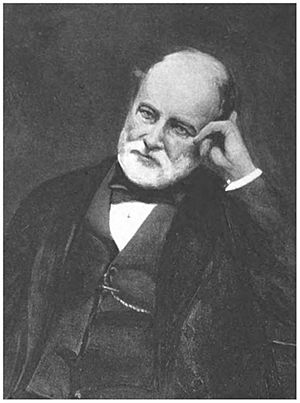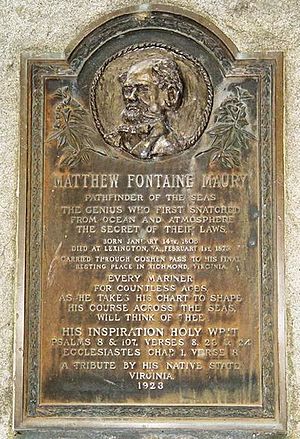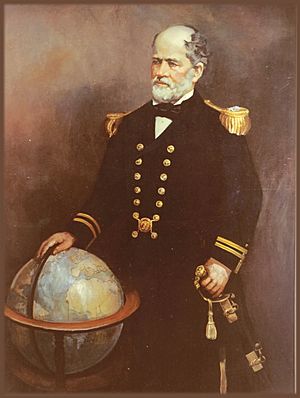Matthew Fontaine Maury facts for kids
Quick facts for kids
Matthew Fontaine Maury
|
|
|---|---|
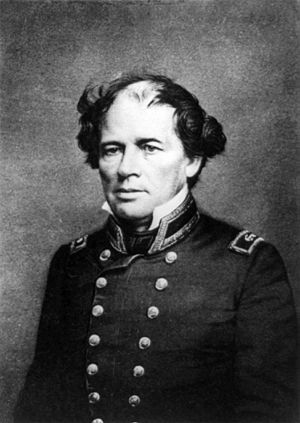
as a U.S. Navy lieutenant in 1853
|
|
| Born | January 14, 1806 |
| Died | February 1, 1873 (aged 67) Lexington, Virginia, U.S.
|
| Resting place | Hollywood Cemetery |
| Nationality | American |
| Occupation | Oceanographer, naval officer, educator, author |
| Military career | |
| Allegiance | |
| Service/ |
|
| Years of service | 1825–1861 (USN) 1861–1865 (CSN) |
| Rank | |
Matthew Fontaine Maury (January 14, 1806 – February 1, 1873) was an American oceanographer and naval officer. He served the United States Navy for many years. Later, he joined the Confederacy during the American Civil War.
Maury was known as the "Pathfinder of the Seas." Many people consider him a founder of modern oceanography. He wrote many books and articles about the ocean. His book, The Physical Geography of the Sea (1855), was the first complete book on oceanography.
In 1825, when he was 19, Maury joined the United States Navy. He started as a midshipman on the frigate USS Brandywine. Right away, he began studying the seas and how to navigate ships. After a leg injury made it hard for him to go to sea, Maury focused on studying navigation, weather, winds, and ocean currents.
He became the leader of the United States Naval Observatory. This office was in charge of charts and instruments. Maury studied thousands of old ship logs and charts there. He published the Wind and Current Chart of the North Atlantic. This chart showed sailors how to use ocean currents and winds to make their trips much shorter. Navies and merchant ships all over the world started using Maury's system for recording ocean data. This helped create charts for all major trade routes.
When the American Civil War began, Maury, who was from Virginia, left his job in the U.S. Navy. He joined the Confederacy. During the war, he worked in the Southern United States, Great Britain, and France as a Confederate representative. He helped the Confederacy get a ship, CSS Georgia. He also tried to convince European countries to help stop the war. After the war, Maury was pardoned. He then became a teacher at the Virginia Military Institute in Lexington, Virginia.
He died at the institute in 1873. Before he died, he had finished a long lecture tour about weather forecasting on land. He also completed his book, Geological Survey of Virginia, and a new series of geography books for young people.
Contents
Maury came from the Maury family, a well-known family in Virginia. They were Huguenots, which means they were French Protestants. His grandfather, Reverend James Maury, was a teacher to future U.S. President Thomas Jefferson. Maury also had Dutch-American family from the Minor family in early Virginia.
He was born in 1806 in Spotsylvania County, Virginia, near Fredericksburg. His parents were Richard and Diane Minor Maury. When he was five, his family moved to Franklin, Tennessee. Matthew wanted to join the Navy like his older brother, John Minor Maury. John was a Navy officer who died from yellow fever after fighting pirates. Because of John's death, Matthew's father, Richard, did not want him to join the Navy.
Maury thought about going to West Point for a better education. But in 1825, at age 19, he got a Navy appointment. This happened with help from Sam Houston, a family friend and a representative from Tennessee.
Maury joined the Navy as a midshipman on the frigate Brandywine. This ship was taking the elderly Marquis de La Fayette back to France. Maury immediately started studying the seas and how to navigate. He became very interested in this during his trip around the world on the USS Vincennes. This was the first U.S. warship to travel all the way around the globe.
Mapping the Oceans
Maury's time sailing ended when he was 33. He broke his right leg in a stagecoach accident. After that, he studied naval weather, navigation, and charting winds and currents. He believed his work was inspired by a Bible verse, Psalm 8, which talks about having "dominion over the works of thy hands... and whatsoever passeth through the paths of the seas."
In 1842, Maury became the officer in charge of the "Depot of Charts and Instruments" in Washington, DC. This office had many old, unorganized ship logs and records. Maury decided to organize this information to help improve sailing. He also started a system where ship captains would report their observations about sea conditions.
His hard work led to international recognition. In 1847, he published the Wind and Current Chart of the North Atlantic. Because of his work, the depot was renamed the United States Naval Observatory and Hydrographical Office in 1854. He stayed in this role until he resigned in April 1861. Maury also strongly supported creating a national observatory. He asked former U.S. President John Quincy Adams, who loved astronomy, for help. Adams helped get money for what became the Naval Observatory.
Maury noticed that ship captains had learned many lessons about how winds and currents affected their journeys. These lessons were written in their logbooks but were often forgotten. At the Observatory, Maury found thousands of old ship logs and charts. He carefully read through them, collecting information about winds, calm areas, and currents for all seas and seasons. His goal was to share this important information with all captains.
Maury's studies of ocean currents and the whaling industry made him think there might be a warm, ice-free passage in the north between the Atlantic and Pacific oceans. He thought he saw a warm current moving into the Arctic. Old whaling ship logs also showed that whales killed in the Atlantic had harpoons from ships in the Pacific, and vice versa. This seemed unlikely if the whales had traveled all the way around Cape Horn.
Lieutenant Maury published his Wind and Current Chart of the North Atlantic. This chart taught sailors how to use ocean currents and winds to their advantage. It greatly reduced the time it took for voyages. His books, Sailing Directions and Physical Geography of the Seas and Its Meteorology, are still important today. Maury's system for recording oceanographic data was used by navies and merchant marines worldwide. This helped create charts for all the main trade routes.
Maury's team at the Naval Observatory included young officers called midshipmen. They helped him with his work. Their time at the observatory was usually short, so Maury constantly had to train new people. He worked on astronomy and nautical science. As his fame grew, many young midshipmen wanted to work with him. This meant he always had good assistants.
Maury also pushed for changes in the Navy. He wanted a school for the Navy, similar to the Army's United States Military Academy. His writings, like "Scraps from the Lucky Bag," helped bring about many changes. One of his dreams, the creation of the United States Naval Academy, finally came true.
In 1848, he helped start the American Association for the Advancement of Science (AAAS).
In 1849, Maury spoke about the need for a railroad across the country. He wanted it to connect the Eastern United States to California. He suggested a southern route, starting in Memphis, Tennessee. He argued that a southern route through Texas would avoid winter snows. It could also open up trade with northern Mexico. Maury also supported building a railroad across the Isthmus of Panama.
For his scientific work, Maury was chosen to join the American Philosophical Society in 1852.
International Cooperation for Weather
Maury also asked for an international weather service for both sea and land. After charting the seas, he wanted to chart land weather. However, the U.S. Congress did not provide money for a land weather system.
Maury believed that we could only truly understand the sea through international teamwork. He suggested that the United States invite countries around the world to a meeting. The goal was to create a "universal system" for studying weather. He was a key leader at this first scientific conference in Brussels in 1853. Within a few years, countries that owned three-fourths of the world's ships were sending their ocean observations to Maury in Washington, DC. He would then analyze the information and share the results globally.
The United States sent Maury as its representative to the Brussels Conference. As a result, many nations, even those who were often enemies, agreed to share land and sea weather data. They decided to use the same standards for recording information. Soon after, countries like Prussia, Spain, Brazil, and others joined this effort.
The Pope even created special flags for ships from the Papal States. These flags were given only to ships that filled out and sent Maury's special logbooks to Washington, DC.
Views on Slavery
Maury's ideas about slavery were complex. He, along with some politicians and business leaders, imagined a future for slavery that connected the United States, the Caribbean, and the Amazon region in Brazil. He believed that the future of U.S. trade was in South America. He thought white southerners and their enslaved people could settle there. Maury claimed there was "work to be done by Africans with the American axe in his hand."
In the 1850s, he studied a way to send Virginia's enslaved people to Brazil. He saw this as a way to slowly end slavery in Virginia. Maury knew about a survey of the Amazon region done by Navy Lt. William Lewis Herndon in 1853. This expedition aimed to map the area for trade. The idea was that American traders could go "with their goods and chattels [including enslaved people] to settle and to trade goods from South American countries along the river highways of the Amazon valley."
Brazil still had legal slavery, but it had stopped bringing new enslaved people from Africa in 1850. Maury suggested that moving enslaved people from the United States to Brazil would reduce or end slavery in many parts of the southern U.S. over time. It would also stop new enslavement in Brazil. However, Maury's main concern was not the freedom of enslaved people. Instead, he wanted to help slaveholders in Virginia and other southern states. Maury wrote to his cousin, "Therefore I see in the slave territory of the Amazon the SAFETY VALVE of the Southern States."
Maury wanted to open the Amazon River to free navigation for all ships. However, Emperor Pedro II's government strongly rejected these ideas. Maury's plan also got little support in the United States, especially in the South, which wanted to keep slavery. By 1855, the plan had failed. Brazil allowed free navigation in the Amazon to all nations in 1866. This happened only when it was at war and needed free navigation in the area.
Maury himself did not own enslaved people. However, he did not actively oppose slavery. Some historians say he saw slavery as wrong but did not try to force others to free enslaved people. Other recent studies show that he had strong ties to the slave trade, which connects his scientific achievements to a pro-slavery stance.
American Civil War
Maury was against states leaving the Union. In 1860, he wrote letters to the governors of New Jersey, Pennsylvania, Delaware, and Maryland. He urged them to stop the country from going to war. But when Virginia decided to leave the Union in April 1861, Maury resigned from the U.S. Navy. He chose to fight for the South. When the American Civil War started, Maury joined the Confederacy.
After leaving the U.S. Navy, the governor of Virginia made Maury a commander in the Virginia Navy. When this navy joined the Confederate Navy, Maury became a Commander in the Confederate States Navy. He was put in charge of the Naval Bureau of Coast, Harbor, and River Defense. In this role, Maury helped create the first electrically controlled naval mine. These mines caused a lot of trouble for U.S. ships. He had experience with underwater cables and electricity from working with Cyrus West Field and Samuel Finley Breese Morse. These naval mines, called torpedoes back then, were like today's contact mines. The Secretary of the Navy said in 1865 that they "cost the Union more vessels than all other causes combined."
In September 1862, Maury was sent to England for special service. This was partly because of his international fame. He was also sent away because some higher-ranking officers were jealous of him. In England, he tried to buy and equip ships for the Confederacy. He also tried to convince European countries to recognize and support the Confederacy. Maury traveled to England, Ireland, and France. He got ships and supplies for the Confederacy. He gave speeches and wrote in newspapers, trying to get European nations to help end the American Civil War. However, he was not successful. Maury did make connections for the Confederacy with Emperor Napoleon III of France and Archduke Maximilian of Austria. Maximilian became Emperor of Mexico on April 10, 1864.
Early in the war, the Confederate States Congress asked Maury and Francis H. Smith to create a system of weights and measures. Smith was a mathematics professor at the University of Virginia.
Later Life and Legacy
Maury was in the West Indies on his way back to the Confederacy when he learned the war was over. The war had caused a lot of damage in Fredericksburg, where Maury's family lived. Robert E. Lee and other friends advised him not to return to Virginia. So, he sent a letter of surrender to U.S. naval forces in the Gulf of Mexico and went to Mexico. There, Maximilian, whom he had met in Europe, made him "Imperial Commissioner of Colonization." Maury and Maximilian planned to encourage former Confederates to move to Mexico. They wanted to build new settlements for displaced Confederates and other immigrants. When Lee heard about the plan, he wrote to Maury saying he preferred to stay and help rebuild Virginia. In the end, the plan did not attract many immigrants. Maximilian faced growing opposition in Mexico and ended the plan. Maury then returned to England in 1866 and found work there.
In 1868, the U.S. government pardoned him. He returned to the U.S. and became a physics professor at the Virginia Military Institute in Lexington, Virginia. While there, he completed a physical survey of Virginia. He wrote about it in his book The Physical Geography of Virginia. He had once been a gold mining superintendent and had studied geology. So, he was well-prepared to write this book. He wanted to help Virginia rebuild after the war by finding and using minerals and improving farming. He gave many lectures in the U.S. and other countries. He also pushed for a state agricultural college to be part of the Virginia Military Institute. This led to the creation of the Virginia Agricultural and Mechanical College in Blacksburg in 1872. This college was later renamed Virginia Polytechnic Institute and State University. Maury was offered the job as its first president but turned it down because of his age.
He had also been considered for president of the College of William & Mary in Williamsburg, Virginia, in 1848. He thought about becoming president of St. John's College in Maryland, the University of Alabama, and the University of Tennessee. From his letters, it seems he preferred to be near General Robert E. Lee in Lexington. Lee was president of Washington College. Maury was one of the people who carried Lee's coffin at his funeral. Maury also gave talks in Europe about working together on a land weather bureau. He had done similar work charting winds and predicting storms at sea years before. He gave speeches until his last days. He collapsed during one speech. After he recovered, he went home and told his wife, Ann Hull Herndon-Maury, "I have come home to die."
His Last Days
He died at his home in Lexington at 12:40 pm on Saturday, February 1, 1873. He was very tired from traveling and giving speeches about land meteorology. His oldest son, Major Richard Launcelot Maury, and son-in-law, Major Spottswood Wellford Corbin, were with him. Maury asked his daughters and wife to leave the room. His last words were "all's well," which is a nautical phrase meaning calm conditions at sea.
His body was displayed in the Virginia Military Institute library. Maury was first buried in the Gilham family vault in Lexington's cemetery, near Stonewall Jackson. After some time, his remains were moved through Goshen Pass to Richmond, Virginia, the next year. He was reburied between Presidents James Monroe and John Tyler in Hollywood Cemetery in Richmond, Virginia.
Why We Remember Him

After many years of national and international work, Maury became famous and received many honors. He was knighted by several nations and given medals with precious gems. He also received a collection of all medals made by Pope Pius IX. Father Angelo Secchi, who studied with Maury at the United States Naval Observatory from 1848 to 1849, dedicated a book to him. They remained friends for life. Maury also had religious friends like James Hervey Otey, his former teacher. Otey worked with Bishop Leonidas Polk to build the University of the South in Tennessee. Maury gave a speech there.
As a U.S. Navy officer, he was not allowed to accept awards from foreign countries. Some awards were offered to Maury's wife, Ann Hull Herndon-Maury, who accepted them for her husband. Some of these awards are now at the Virginia Military Institute or on loan to the Smithsonian. He became a commodore in the Virginia Provisional Navy and a Commander in the Confederacy.
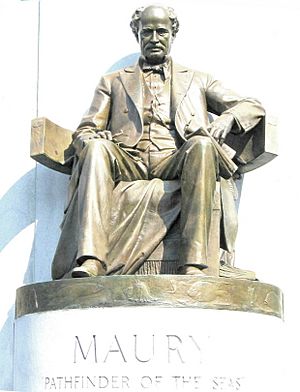
Several buildings on college campuses were named after him. Maury Hall at the University of Virginia was home to the Naval Science Department. It was renamed in 2022. The first building of the College of William & Mary Virginia Institute of Marine Science is also named Maury Hall. Another Maury Hall housed engineering departments at the United States Naval Academy in Annapolis, Maryland. On February 17, 2023, the Academy renamed this building after Jimmy Carter, a Naval Academy graduate and former U.S. President. This change was suggested by a commission looking at Confederate-related names on military sites. James Madison University also has a Maury Hall. In 2020, after the George Floyd protests, students asked for the building to be renamed. The university president agreed to recommend renaming Maury Hall.
Ships have also been named in his honor, including several vessels named USS Maury. There was also USS Commodore Maury (SP-656), a patrol vessel from World War I, and a World War II Liberty Ship. Tidewater Community College in Norfolk, Virginia, owns the R/V Matthew F. Maury. This ship is used for oceanography research and student trips. In March 2013, the U.S. Navy launched the oceanographic survey ship USNS Maury (T-AGS-66).
The Mariners' Lake, in Newport News, Virginia, was named after Maury. But its name was changed during the George Floyd protests. The lake is on the Mariners' Museum property.
The Maury River, in Rockbridge County, Virginia, is also named after him. This is near the Virginia Military Institute where Maury taught. There is also a Maury crater on the Moon.
Matthew Fontaine Maury High School in Norfolk, Virginia, is named after him. Matthew Maury Elementary School in Alexandria, Virginia, was built in 1929. In 1944, a school in Arlington, Virginia, was renamed to honor Maury. Since 1976, that building has been home to the Arlington Arts Center. Matthew Fontaine Maury School in Fredericksburg was built in 1919-1920 and closed in 1980. The building is now condominiums and is on the National Register of Historic Places. Next to it is Maury Stadium, built in 1935, which is still used for high school sports.
Many historical markers remember Maury throughout the South. These include markers in Richmond, Virginia, Fletcher, North Carolina, Franklin, Tennessee, and several in Chancellorsville, Virginia.
The Matthew Fontaine Maury Papers collection at the Library of Congress has over 14,000 items. These documents show Maury's long career and scientific work. They include letters, notebooks, lectures, and speeches.
On July 2, 2020, the mayor of Richmond ordered the removal of a statue of Maury. The statue was put up in 1929 on Richmond's Monument Avenue. The mayor used emergency powers to remove it. He said the statue was a "severe, immediate and growing threat to public safety."
See also
 In Spanish: Matthew Fontaine Maury para niños
In Spanish: Matthew Fontaine Maury para niños
- Bathymetric chart
- Flying Cloud
- National Institute for the Promotion of Science
- Notable global oceanographers
- Prophet Without Honor



